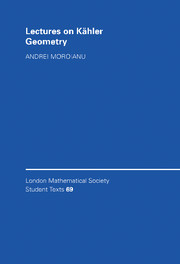Book contents
- Frontmatter
- Contents
- Introduction
- Part 1 Basics of differential geometry
- Part 2 Complex and Hermitian geometry
- Part 3 Topics on compact Kähler manifolds
- Chapter 16 Chern classes
- Chapter 17 The Ricci form of Kähler manifolds
- Chapter 18 The Calabi–Yau theorem
- Chapter 19 Kähler–Einstein metrics
- Chapter 20 Weitzenböck techniques
- Chapter 21 The Hirzebruch–Riemann–Roch formula
- Chapter 22 Further vanishing results
- Chapter 23 Ricci-flat Kähler metrics
- Chapter 24 Explicit examples of Calabi–Yau manifolds
- Bibliography
- Index
Chapter 17 - The Ricci form of Kähler manifolds
Published online by Cambridge University Press: 07 January 2010
- Frontmatter
- Contents
- Introduction
- Part 1 Basics of differential geometry
- Part 2 Complex and Hermitian geometry
- Part 3 Topics on compact Kähler manifolds
- Chapter 16 Chern classes
- Chapter 17 The Ricci form of Kähler manifolds
- Chapter 18 The Calabi–Yau theorem
- Chapter 19 Kähler–Einstein metrics
- Chapter 20 Weitzenböck techniques
- Chapter 21 The Hirzebruch–Riemann–Roch formula
- Chapter 22 Further vanishing results
- Chapter 23 Ricci-flat Kähler metrics
- Chapter 24 Explicit examples of Calabi–Yau manifolds
- Bibliography
- Index
Summary
Kähler metrics as geometric Um-structures
We start with a short review on G-structures which will help us to characterize Kähler and Ricci-flat Kähler metrics. Let M be an n-dimensional manifold and let G be any closed subgroup of Gln(ℝ).
Definition 17.1. A topological G-structure on M is a reduction of the principal frame bundle Gl(M) to G. A geometrical G-structure is given by a topological G-structure G(M) together with a torsion-free connection on G(M).
Let us give some examples. An orientation on M is a -structure. An almost complex structure is a Glm(ℂ)-structure, for n = 2m. A Riemannian metric is an On-structure. Recall (Proposition 4.7) that if the group G is the stabilizer of an element ξ of some representation ρ : Gln(ℝ) ξ End(V), then a G-structure is simply a section σ in the associated bundle Gl(M)× ρ, where O denotes the Gln(ℝ)-orbit of ξ in V. By Theorem 5.16, the G-structure is geometrical if and only if there exists a torsion-free linear connection on M with respect to which σ is parallel.
Proposition 17.2. The Um-structure defined by an almost complex structure J together with a Hermitian metric h on a manifold M is geometrical if and only if the metric is Kähler.
Proof. The point here is that if G is a closed subgroup of On then there exists at most one torsion-free connection on any G-structure (by the uniqueness of the Levi-Civita connection).
- Type
- Chapter
- Information
- Lectures on Kähler Geometry , pp. 119 - 124Publisher: Cambridge University PressPrint publication year: 2007

